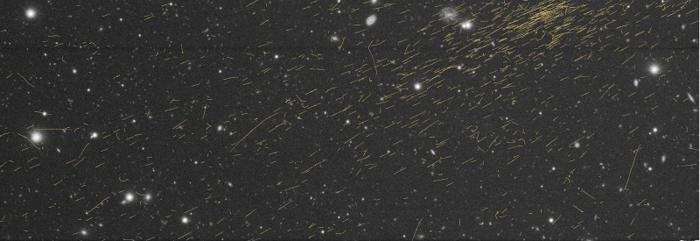A reoccurring series of anomalous “tracks” that appear in images taken by the Subaru Telescope in Hawaii, which the instrument’s software previously dismissed as noise, have been revealed to likely be the result of collisions between cosmic rays and the Earth’s atmosphere.
The resulting air showers caused by these collisions, according to researchers involved in the findings, may hold the key to unraveling the mystery of dark matter and other exotic particles that have perplexed physicists trying to unravel the nature of the Universe for decades.
Cosmic Ray Powers Deliver Extensive Air Showers
The most energetic particles in the Universe, cosmic rays, are challenging to measure and analyze. So, the ability to actually capture images of the extensive air showers they create when colliding with the atmosphere may finally open a window into understanding their most enigmatic properties.
“With conventional observation methods, it is challenging to distinguish between the types of particles that constitute extensive air showers,” explained Associate Professor Toshihiro Fujii from the Graduate School of Science at Osaka Metropolitan University in a press release announcing the discovery. “Our method, on the other hand, has the potential to determine the nature of individual particles.”
Surprisingly, given the value of studying these types of particles, the telescope’s software initially dismissed their images as noise since the anomalous tracks they created in the images were clearly not distant cosmic phenomena like the stars and galaxies those astronomers were looking for. Luckily, Fujii and his colleague graduate student Fraser Bradfield figured out that what the observatory’s astronomers were seeing as anomalous tracks were, in fact, direct evidence of these cosmic ray-induced “extensive air showers.”
In fact, by combing through the data collected by the Subaru Telescope, which sits atop the Mauna Kea volcano, the duo located and analyzed over 17,000 captured between 2014 and 2020. Along with periodic anomalous tracks of likely single cosmic ray collisions that peppered some of the images, the team says they found 13 particularly intriguing images that contained evidence of what was almost certainly extensive air showers.
Anomalous Tracks May Explain Why We Live in a Matter-Dominated Era
Published in the journal Scientific Reports, the Osaka Metropolitan team’s research notes that the wide-angle prime focus camera was seeing these anomalous tracks. So, astronomers who want to use their technique should try to utilize similar equipment and methods. They also point out that their discovery of the true nature of these anomalous tracks is merely a first step and hope that the technique and method they have discovered will allow researchers trying to unravel the nature and origin of the Universe itself to find some answers.
“By integrating our method with conventional approaches, we hope to advance our understanding of extensive air showers,” Fujii concluded. “This technique may allow us to search for dark matter or other exotic particles, offering additional insights into the transition of the Universe into a matter-dominated era.”
Christopher Plain is a Science Fiction and Fantasy novelist and Head Science Writer at The Debrief. Follow and connect with him on X, learn about his books at plainfiction.com, or email him directly at christopher@thedebrief.org.

